Healing takes time. When we’re working to heal parts of our body, we often have to make real changes to our diet and lifestyle along with taking medicine to give a little boost. In traditional medicine, there is no magic pill that immediately heals a wound or an ulcer or a headache. We don’t just throw a bandaid on the problem either. We work to heal the cause of the problem while also relieving the symptoms.
There’s always an exception that proves the rule. For me, it’s the ghee eye bath (known in Ayurveda as Netra Basti). Not only does it give immediate relief to tension and eye strain, the results can last for weeks (or even months, depending on what’s going on). And yes, it is exactly what it sounds like—putting ghee in your eyes.
Most of the time when I tell to people about the ghee eye bath, they’re pretty hesitant to try. But it sounds a lot scarier than it is. Ghee is soothing and softening to callused eyes and it doesn’t sting or feel like you’re opening your eyes underwater. I love this healing treatment so much that — after a bit of persuasion — I got the whole ASC team to do an eye bath. We even filmed it for Back Bar Sessions (video below)!
Here’s some background on the benefits of this treatment.
What is Ghee?
Ghee is a type of clarified butter. Butter has several components to it—water, milkfat, and milk solids. To clarify it, unsalted butter is heated so that these three components separate—the water is evaporated and the milk solids are removed, leaving only the milk fat. That’s the ghee!
Ghee has a long history of use in both cooking and healing. It’s absolutely perfect to cook with because without the water content, it has a higher smoke point and a longer shelf life than butter. That means it doesn’t oxidize to create free radicals, and the nutrients in the fat itself aren’t compromised until it reaches a much higher temperature on your burner. The flavor is amazing, too! It’s similar to butter, but since it oxidizes at a higher temperature the richness of the flavor stays intact longer.
It’s also really cheap and easy to make at home. Note that because you’re heating the butter and removing everything but the fats, you’re concentrating whatever fat soluble constituents are in it. Since most pesticides and hormones are fat soluble, it is very important to choose organic, grass fed butter to make your ghee with. Here’s an awesome tutorial.
While making ghee is physically very simple, it is rich with spiritual subtleties. Ghee’s beginnings are ancient and rooted in Ayurveda. In that tradition it is a sacred and humbling practice to make and use ghee.
Traditions of Ghee
In Ayurveda and Hindu traditions, the cow is considered a sacred beast and is connected with the Mother because she offers such life-giving nourishment. Cow products like milk, yogurt, buttermilk, butter, paneer, and ghee are all supportive for our bodies and are highly revered. In these customs, butter is considered the essence of the cow and ghee is considered the essence of the butter.
In this way, the use of ghee is very spiritually charged. It is physically relieving and energetically enhancing because it has a unique balance of humbling, soothing purity and stimulating, fiery energy. Ghee gently softens and nourishes the organs, kindling internal fire without adding extra heat to the body. It is also seen as a stable and dependable food source that increases overall vitality.
It comes as no surprise, then, that the creation of the ghee is very spiritual. The way that the butter is made, churned, and processed makes a difference in the overall balancing effect of the finished ghee. The moon, which is also associated with the life-giving mother, needs to be waxing in the sky for all of the correct energetic properties to be encompassed in the ghee. The ghee should be made over fire (not electric heat) to increase the robust internal energy that it offers. Most importantly, within the process of creation, the environment needs to be positive and beautifully filled with intention.
Ghee has been used for so long that the healing uses are almost endless—I find myself thinking, “ghee for everything!” Externally, it makes a wonderful massage or bath oil. Internally it is used to oil pull, to aid digestion, and as an infusion to increase penetration of herbal medicine.
For the purpose of this article—and because I could write a book about how amazing ghee is—we’ll focus on the tradition of Netra Basti, the ghee eye bath.
Netra Basti—The Ghee Eye Bath
Netra Basti means “eye cleanse.” That’s exactly what we’re doing when we pour ghee into the eyes and let it pull out all of the dirt and grime. Remember that ghee is both physically and energetically healing and this practice is no different. Not only does this bath pull trapped dirt and salt from inside the eyes, it can also pull emotions and memories forward.
I was relaxing with a close friend after her first eye bath and she told me a very emotionally charged story that she hadn’t thought of in years. After she told the story she said, “well, that was hiding in my eyes.” That statement was powerful for me. It was the first time I was able to make a tangible connection between the physical body and emotional pain.
I tend to get jaw tension and eyestrain. They typically all happen around the same time and come with stress (that makes sense, right?).
Dealing with all those things at the same time can lay me out for a couple of days at a time, but can I please tell you that the ghee eye bath changed everything for me? The first time I had it done, I felt all the strain leave my eyes, then my jaw, then my neck and my shoulders—relief cascaded all the way down my body.
I had no idea that the tension I had been holding in my eyes had affected every part of me and as I felt it physically melt away, emotions that had been deeply hidden bubbled up and softly filled in the spaces that had felt rigid with stress before. I felt emotionally clear and open for days afterward—my experiences were more vivid, and my smile came a lot easier. I have fallen in love with the ghee eye bath.
The Tangible Benefits of a Ghee Eye Bath
I can honestly go on about my personal experience with the eye baths forever but one thing we learn about treatments is that some people are convinced with personal experience stories and other people need to see a list of physical benefits like this one:
- Cleanses the eyes – This is why it’s called a bath! Throughout our days, dust, mucous, minerals and other substances can all get trapped in our eyes. The ghee loosens up what’s in there and all that gunk floats to the surface. For some people, a little bit of salt is trapped in the tear duct and loosening that up might sting a little bit—that’s a good thing. The stinging will stop after a few minutes.
- Helps tear ducts – Our eyes are in use from the time we wake up to the time we go to bed. They’re one of our few exposed muscles and they are really sensitive to the environment.
- Relaxes eyes – Many of us spend hours a day in synthetic light, looking at a screen. Like all muscles, our eyes get tired after continuous use. The ghee deeply nourishes and suspends the eye to let it fully relax.
Without being too cliche (I’m not sure that’s possible here), the eyes are said to be the windows to the soul. We experience so much of our lives through our eyes that visual trauma has a way of deeply impacting us. The practice of Netra Basti softens the way we view trauma and helps us feel supported as we work through it. Truthfully, this practice is a gift.
Watch Us Perform a Ghee Eye Bath
We got up close and personal and did ghee eye baths in the office and recorded it for Back Bar Sessions. Take a look!
Click Here to See More Back Bar Sessions Videos
How to do a Ghee Eye Bath
You can do this on your own, or you can do this with a partner. To do it on your own, you’ll just need to pick up eyecups from your corner pharmacy, fill them with the warm ghee, and tilt your head back for a few minutes to let the ghee soak into your eyes.
With a partner it’s a little bit more complicated because there is an extra step of making the eye cup. When you’re working with a partner it can be a little scary (because warm butter in your eyes is admittedly a bit strange in the beginning) so it’s important to be communicating during every step of the way. Make sure that the person receiving the eye bath is making all of the decisions and guiding the actions of the person giving the eye bath.
Everything you’ll need for your bath:
- Water
- Whole wheat flour (you can use gluten free flour too)
- Ghee
- Clean towels—ghee can be messy, I like to have one underneath of the receiver’s head, and another one for use if the dough leaks a little bit.
Directions:
- Mix the flour and the water together to form a ball that has the consistency of pizza dough. This is your eye cup that will hold the ghee while it’s sitting in your eye. Note: Take some time with this step. The consistency is important because you want it to be able to stick to the skin around the eyes to hold in the ghee, but you don’t want it too wet or it won’t hold it’s shape.
- Heat the ghee. I like to do this by putting it in a glass jar and putting the jar in a water bath on medium/low heat on the stove.To test the temperature of the ghee, swish your finger back and forth to make sure that it isn’t too hot. You want it to be warm to the touch but not uncomfortable.
- The receiver lays down on his/her back, face up while the giver forms the eyecup around the receiver’s eye.When you’re doing this step, you want to make sure that there is a seal around the entire area. If there is a way for the ghee to escape its little cup, it will and it will create a big mess.
- Now the fun part. When the receiver is ready, pour the warm ghee into the dough eyecup onto the receiver’s closed eye.You want to completely cover the eye. When the receiver is ready, he or she opens her eye, looks every direction, and blinks at least 7 times. Note: The ghee is very nourishing and it feels good, but it can also have the tendency to pull out any salt deposits and clean the tear ducts so some stinging is common, but will dissipate quickly.
- If both the giver and the receiver are comfortable, a slight eyeball massage can be even more relaxing to the muscle. With clean hands and a VERY short fingernail on their dominant index finger, the giver can slowly massage the receiver’s closed eye. The receiver controls the pressure and depth of the massage and when he or she is finished.
- When the receiver feels finished with the ghee eye bath, the giver makes a little spout from the whole wheat flour and tips the receiver’s head so that the ghee will drain into an empty bowl. Remove the dough ball and pat the extra oil from the receiver’s face.
- Repeat with the other eye. The giver and the receiver can (and should) switch places, but the both eyes on one person should be done before they switch.
Have you ever had a ghee eye bath? What was your experience like?
Sources:
The Discovery Eye Foundation – The Optic Nerve and its Visual Link to the Brain
Les Nouvelles Esthétiques & Spa – Ghee Eye Bath
What is Ghee – Health Benefits of Ghee
Amrita Veda – Ghee – An Ayurvedic Perspective
Ayurveda Sedona – Holy Cow
Svastha Ayurveda – Medicated Ghee
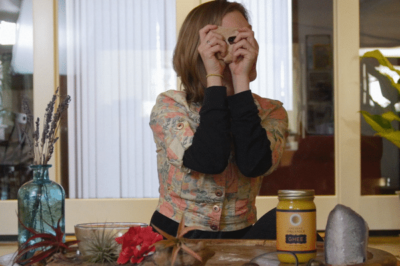

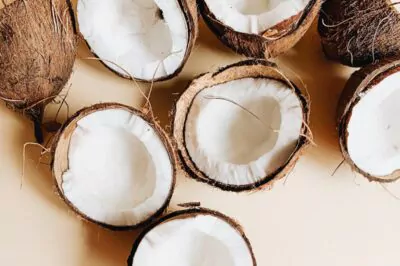
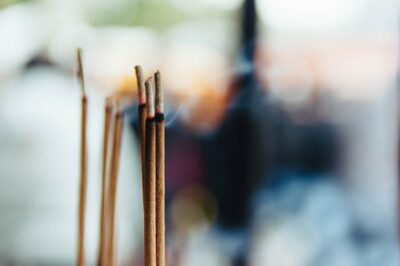
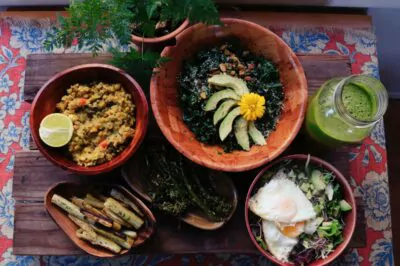
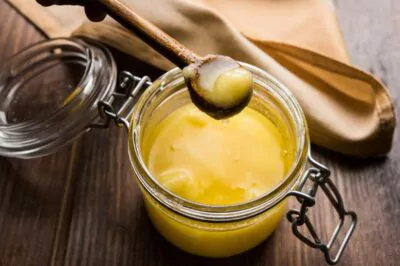
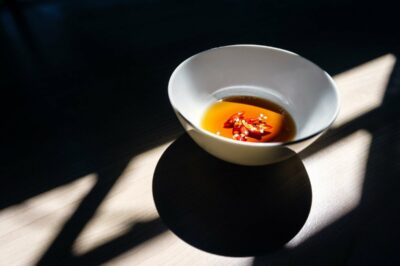
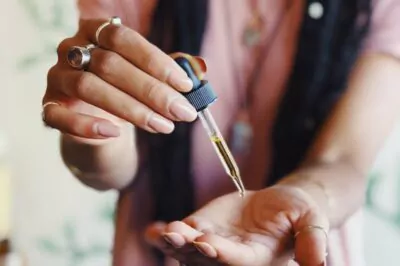
I did this months ago by myself and it was a bit of a challenge. Any suggestions for doing it in your own? I was amazed at how my body felt! It was an unexpected relaxing experience! Very relaxing, mindful and meditative. Such unexpected results. Can you explain how that happens?
Thank you!
Cssoapery.com
Hi, I have a question. Ghee won’t get into the eyes ?
I had always wondered what a ghee eye bath is. Thank you so much for providing such great detail and showing the demo!